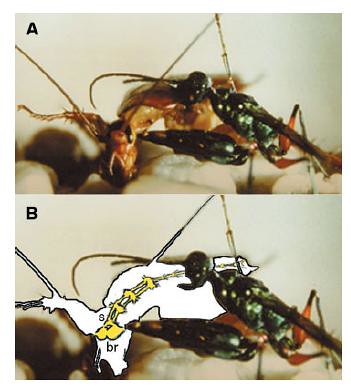 Many parasites alter their hosts behavior by small manipulations in the brain that go largely unnoticed by the host until its eaten by another. But not all use so much finesse. This week's parasite is probably the rudest as far as mechanisms go - luckily, their hosts are cockroaches, so we don't hold it against them.
Many parasites alter their hosts behavior by small manipulations in the brain that go largely unnoticed by the host until its eaten by another. But not all use so much finesse. This week's parasite is probably the rudest as far as mechanisms go - luckily, their hosts are cockroaches, so we don't hold it against them.
I'm talking about the Emerald Cockroach Wasp. As with many parasitic wasps, it needs to inject its eggs into the host to incubate. When the eggs hatch, they'll feed on the host, cocoon, and emerge adult wasps. But most parasitic wasps paralyze their hosts and drag the bodies somewhere to feed the soon-to-be-born young. Such forethought would be considerate compared to the behavior of the Emerald Cockroach Wasp.
 You see, the Emerald Cockroach Wasp is rather small compared to most parasitic wasps, and can't really "drag" its victim anywhere. Instead of paralyzing the cockroach, the wasp injects venom into its host cockroach which cause the insect to lose its front limbs (specifics, here). This causes the roach to bow head down, exposing its ganglion. The wasp then stings again, aiming for the brain. It was found in 2007 that the venom actually blocks the neurotransmitter octopamine. This effect is so precise that the cockroach's survival instincts are turned off, but its motor capabilities (like walking) are left unimpaired. After the initial paralysis is over and the roach has been essentially zombified, the wasp chews off parts of the roach's antennae and uses them like a leash to lead the roach to a burrow. It then fills the backside of the roach with eggs and seals them both in.
You see, the Emerald Cockroach Wasp is rather small compared to most parasitic wasps, and can't really "drag" its victim anywhere. Instead of paralyzing the cockroach, the wasp injects venom into its host cockroach which cause the insect to lose its front limbs (specifics, here). This causes the roach to bow head down, exposing its ganglion. The wasp then stings again, aiming for the brain. It was found in 2007 that the venom actually blocks the neurotransmitter octopamine. This effect is so precise that the cockroach's survival instincts are turned off, but its motor capabilities (like walking) are left unimpaired. After the initial paralysis is over and the roach has been essentially zombified, the wasp chews off parts of the roach's antennae and uses them like a leash to lead the roach to a burrow. It then fills the backside of the roach with eggs and seals them both in.
The roach, still alive (as roaches can live for a long time without eating), simply rests with no desire to escape, until the larvae hatch. The larvae then begin eating the hosts organs, one by one in a systematic manner that keeps it alive the longest, so that the fresh fuel lasts long enough for the larvae to form a cocoon. Only then does the roach, in a totally wasted state, have the bliss of death.
Interestingly enough, the Emerald Cockroach wasp was introduced to Hawaii as an attempt to biocontrol the cockroach population. Unfortunately, the wasps are highly territorial and need very few cockroaches to sustain themselves, so the attempt was ineffective.
Anyhow, here's a little video I found of the behavior...
For more info, check out the links embedded or this article:
R GAL, F LIBERSAT (2008). A Parasitoid Wasp Manipulates the Drive for Walking of Its Cockroach Prey Current Biology, 18 (12), 877-882 DOI: 10.1016/j.cub.2008.04.076
- Log in to post comments

I don't see it as creepy at all. It's beautiful. It is nature at its finest. My severe antipathy for roaches is not the only reason I not bothered by this. The roach has no consciousness of itself. It is not a sentient being. To ascribe fear or pain to it is to assign it a higher developmental level than it possesses. It has instincts but it does not have emotions. This is simply an example of the ingenious nature of survival and evolution.